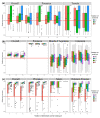Genetic Characterization of the Local Pirenaica Cattle for Parentage and Traceability Purposes
- PMID: 32899488
- PMCID: PMC7552125
- DOI: 10.3390/ani10091584
Genetic Characterization of the Local Pirenaica Cattle for Parentage and Traceability Purposes
Abstract
Pirenaica is the most important autochthonous cattle breed within the Protected Geographic Indication (PGI) beef quality label in the Basque region, in northern Spain. The short tandem repeats (STRs) are powerful markers to elucidate forensic cases and traceability across the agri-food sector. The main objective of the present work was to study the phylogenetic relationships of Pirenaica cattle and other breeds typically raised in the region and provide the minimum number of STR markers for parentage and traceability purposes. The 30-STR panel recommended by the International Society of Animal Genetics-Food and Agriculture Organization of the United Nations (ISAG-FAO) was compared against other commercial STR panels. The 30-STR panel showed a combined matching probability of 1.89 × 10-25 and a power of exclusion for duos of 0.99998. However, commercial STR panels showed a limited efficiency for a reliable parentage analysis in Pirenaica, and at least a 21-STR panel is needed to reach a power of exclusion of 0.9999. Machine-learning analysis also demonstrated a 95% accuracy in assignments selecting the markers with the highest FST in Pirenaica individuals. Overall, the present study shows the genetic characterization of Pirenaica and its phylogeny compared with other breeds typically raised in the Basque region. Finally, a 21-STR panel with the highest FST markers is proposed for a confident parentage analysis and high traceability.
Keywords: Blonde d´Aquitaine; Holstein-Friesian; Limousin; Salers; Terreña; assignment test; identity; microsatellite; multiplex PCR; structure.
Conflict of interest statement
The authors declare no conflict of interest.
Figures



Similar articles
-
Comparison of the effectiveness of microsatellites and SNP panels for genetic identification, traceability and assessment of parentage in an inbred Angus herd.Genet Mol Biol. 2013 Jul;36(2):185-91. doi: 10.1590/S1415-47572013000200008. Epub 2013 Jun 22. Genet Mol Biol. 2013. PMID: 23885200 Free PMC article.
-
Distinct correlations between lipogenic gene expression and fatty acid composition of subcutaneous fat among cattle breeds.BMC Vet Res. 2018 May 23;14(1):167. doi: 10.1186/s12917-018-1481-5. BMC Vet Res. 2018. PMID: 29792205 Free PMC article.
-
Analytical and statistical consideration on the use of the ISAG-ICAR-SNP bovine panel for parentage control, using the Illumina BeadChip technology: example on the German Holstein population.Genet Sel Evol. 2015 Feb 5;47(1):3. doi: 10.1186/s12711-014-0085-1. Genet Sel Evol. 2015. PMID: 25651826 Free PMC article.
-
Development of a 17-plex STR typing system for the identification of individuals and parentage testing in cattle.Sci Rep. 2024 Oct 23;14(1):24998. doi: 10.1038/s41598-024-76547-y. Sci Rep. 2024. PMID: 39443655 Free PMC article.
-
A novel 13-plex STR typing system for individual identification and parentage testing of donkeys (Equus asinus).Equine Vet J. 2020 Mar;52(2):290-297. doi: 10.1111/evj.13158. Epub 2019 Sep 5. Equine Vet J. 2020. PMID: 31398262
Cited by
-
The Revolution of Animal Genomics in Forensic Sciences.Int J Mol Sci. 2023 May 16;24(10):8821. doi: 10.3390/ijms24108821. Int J Mol Sci. 2023. PMID: 37240167 Free PMC article. Review.
-
Animal Forensic Genetics.Genes (Basel). 2021 Apr 1;12(4):515. doi: 10.3390/genes12040515. Genes (Basel). 2021. PMID: 33916063 Free PMC article. Review.
-
Utilizing Indigenous Animal Genetic Resources-Based on Research Into Indigenous Cattle Breeds in the Basque Country in Northern Spain and Indigenous Pig Breeds in Vietnam.Anim Sci J. 2025 Jan-Dec;96(1):e70046. doi: 10.1111/asj.70046. Anim Sci J. 2025. PMID: 40069921 Free PMC article. Review.
References
-
- European Commission . Publication of an Application for Registration Pursuant to Article 6(2) of Regulation (EEC) No 2081/92 on the Protection of Geographical Indications and Designations of Origin. Volume 46 European Commission; Brussels, Belgium: 2003.
-
- BOE (Official Bulletin of the Spanish State) Real Decreto 2129/2008, de 26 de Diciembre, por el que se Establece el Programa Nacional de Conservación, Mejora y Fomento de las Razas Ganaderas. BOE; Madrid, Spain: 2008.
Grants and funding
LinkOut - more resources
Full Text Sources
Miscellaneous

